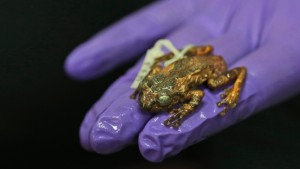 For more than a century, two mysterious tree frog specimens collected by a British naturalist in 1870 and housed at the Natural History Museum in London were assumed to be part of a vanished species, never again found in the wild. A group of scientists, led by renowned Indian biologist Sathyabhama Das Biju, has rediscovered the frogs and also identified them as part of a new genus – one step higher than a species on the taxonomic ranking. Not only have they found the frogs in abundance in northeast Indian jungles, they believe they could also be living across a wide swathe of Asia from China to Thailand.
For more than a century, two mysterious tree frog specimens collected by a British naturalist in 1870 and housed at the Natural History Museum in London were assumed to be part of a vanished species, never again found in the wild. A group of scientists, led by renowned Indian biologist Sathyabhama Das Biju, has rediscovered the frogs and also identified them as part of a new genus – one step higher than a species on the taxonomic ranking. Not only have they found the frogs in abundance in northeast Indian jungles, they believe they could also be living across a wide swathe of Asia from China to Thailand.
Analysis of genetic fragments, physical characteristics and behaviors puts these frogs in a unique genus, dubbed Frankixalus by the research team. The genus includes a species first described in 1876 based solely on museum specimens, says Biju of the University of Delhi. The newfound frog populations live and breed in pools of water in holes in the trunks of canopy trees — a lifestyle that likely kept them off scientists’ radar. Tadpoles eat their mother’s eggs for sustenance, a common practice among frogs that live in low-resource environments.
Fully grown, the frogs are about as big as a golf ball. Uniquely, they feed mostly on vegetation, rather than insects and larvae. Slash-and-burn land clearing for agriculture in the region could already threaten the frogs’ fragile habitat, the biologists write.
Inclusive Learning – Secret of Success
- Mysterious means difficult or impossible to understand
- Vanish means disappear suddenly and completely.
- Renowned means known or talked about by many people; famous.
- Abundance means a very large quantity of something.
- Sustenance means food and drink regarded as a source of strength; nourishment.






